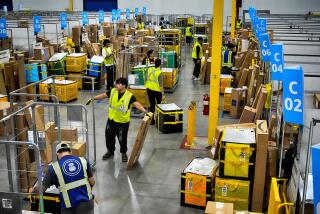Productivity Posts Sluggish 0.9% Rise
WASHINGTON — American workers’ productivity rose just 0.9% last year--the worst showing since the 1981-82 recession--while hourly labor costs sped upward, the government said Monday.
The Labor Department said the 0.9% increase in non-farm productivity--defined as output per hour of work--was less than half of the 2% gain recorded in 1988.
While blaming part of last year’s poor performance on an overall slowdown in economic growth, analysts worried that the combination of weak productivity growth and rising labor costs would further weaken America’s ability to compete internationally.
“That’s a recipe for trouble,” said Allen Sinai, chief economist for Boston Co. “It’s very distressing. . . . It’s symptomatic of an economy that is near the end of expansion.”
The report showed that while productivity was slumping, hourly labor costs--a major inflation measure for businesses--escalated significantly, jumping 5.5%, up from the 4.7% rise of 1988 and the biggest increase since 1982.
“Labor cost increases are probably the scariest part of the report,” said David Wyss, chief economist at DRI-McGraw Hill.
For the October-through-December quarter, non-farm productivity rose a barely perceptible 0.2%, the report said. Hourly labor costs rose at an annual rate of 6.9% in the fourth quarter.
Output in the non-farm sector was up 3.3% in 1989, while the number of hours worked rose by 2.4%, giving the 0.9% increase in productivity.
The report was certain to revive the debate over America’s lagging productivity.
Since the end of the 1981-82 recession, productivity growth has averaged 1.8% a year. While a slight improvement over the 1.2% average growth rate in the 1970s, it was still far below the 3.3% rate of increase posted in the two decades after World War II, when American workers enjoyed healthy wage gains and a rising standard of living.
PRODUCTIVITY
Non-farm business productivity, percent change from previous quarter, seasonally adjusted annual rate. 1988: 1st quarter: +2.8. 2nd quarter: -1.6. 3rd quarter: +3.3. 4th quarter: +1.9.1989: 1st quarter: -1.3. 2nd quarter: +1.1. 3rd quarter: +2.4. 4th quarter: +0.2.
Source: Labor Department
More to Read
Inside the business of entertainment
The Wide Shot brings you news, analysis and insights on everything from streaming wars to production — and what it all means for the future.
You may occasionally receive promotional content from the Los Angeles Times.










